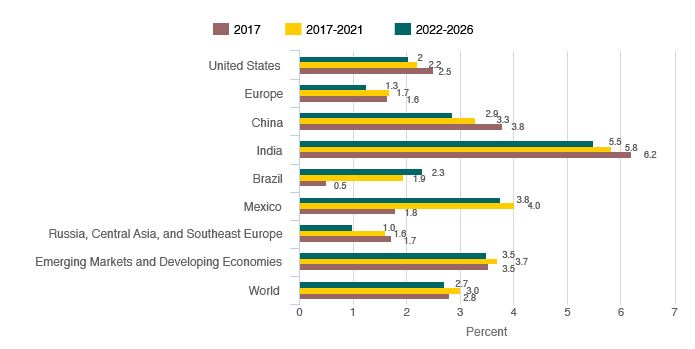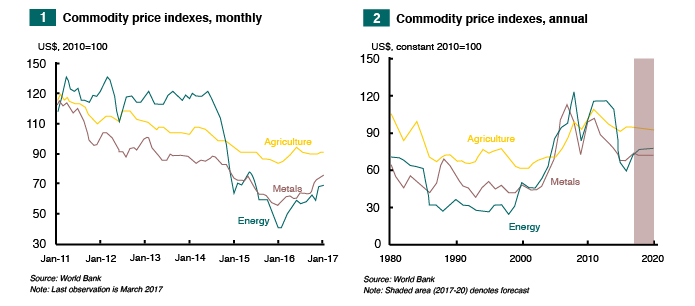Although global commodity markets have been under stress for some time, investors are beginning to look at recent developments more opportunistically. According to the World Bank, prices for most commodities strengthened in the first quarter of 2017. Crude oil is expected to rise to an average of $55 per barrel (bbl) in 2017 from $43/bbl in 2016. Metal prices are projected to increase by 16% as a result of stronger demand in China and agricultural commodity prices are beginning to show early signs of recovery and growth. So why the positive forecasts when diversified commodity indices are down 5% so far this year?
To understand this, we must first look at the sector’s performance over the last quarter-century as well as the fundamental drivers that are emerging in today’s global economic landscape.
Growth of Gross Domestic Product (2017-2026).
 Source: The Conference Board (2017)
Source: The Conference Board (2017)
.
Many commodities are still in recovery-mode from the fall-out that engulfed the sector since the peaking of the super-cycle in 2008. The International Monetary Fund has identified China as being responsible for consuming 20% of global non-renewable energy resources, 23% of major agricultural crops and 40% of base metal demand around the world. The emerging superpower’s easing growth prospects over the past few years have been a major factor in the commodity price correction that saw prices drop by 25% since the peak to the end of 2015. In 2010, Chinese GDP growth was 10.4% and by 2016 it had dropped to 6.7%. The problem has been the knock on effect to global growth. Assuming that China maintains this level of economic growth for the rest of the decade, the global economy will continue to expand at an annual average of 3.3%. That’s lower than the 4% average achieved during the five years before the global financial crisis.
Concerns that subdued growth will weaken demand have been countered by the announcement of China’s ‘One Belt, One Road’ initiative, an economic and diplomatic program set to increase infrastructure and transform trade across Asia, Europe and Africa. There are also promising signs that Saudi Arabia and Russia are prepared to back a nine-month extension of the OPEC supply cuts, a move that will ultimately shrink excess inventories and lift the ceiling on prices. For agriculture, the fundamental demand-supply dynamics of a rising population with rapidly declining arable land availability will inevitably place upward pressure on prices. The Food and Agriculture Organization (FAO) expects that a 70% expansion in global food production will be needed by 2050, while additional research suggests that this will be responsible for a 60% price increase over the same period in food commodity staples such as corn, wheat and rice. Cyclope, specialists in global commodity research, have high expectations for markets this year, predicting that the index of commodity prices will rise by 11%. Goldman Sachs has also expressed high expectations for commodity markets this year.
Source: World Bank (2017)
.
The current global economic environment is also favoring commodity producers, especially across emerging markets. Falling production costs, higher commodity prices and the strength of the US$ compared with local currencies are all lucrative factors. Such a combination is great news for investors in the sector and region as it helps expand margins and secure dividends.
Primal Group enables a return to essential and fundamental value creation by focusing on agricultural opportunities in emerging markets. Exposure to agriculture can take many forms: as a dedicated fund, individual stocks or exchange-traded products. A purer play would be through direct investments in farmland or agricultural businesses, smoothing out some of the volatility applicable in the sector. The United Nations agree, declaring that agricultural investments are one of the most important and effective strategies for economic growth and poverty reduction in developing regions of the world.
